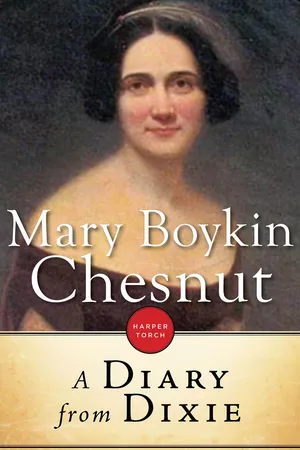
- 342 pages
- English
- ePUB (mobile friendly)
- Available on iOS & Android
A Diary From Dixie
About this book
A Diary from Dixie is the Civil War diary of Mary Boykin Chesnut, society matron and wife of United States senator and Confederate general, James Chesnut, Jr. As an active participant in her husband's career, accompanying him to postings in Montgomery, Richmond, Charleston, and Columbia, Chesnut became an eyewitness to many important events of the war, and, despite being a member of the privileged class, managed to convey the Confederacy's struggle from different points of view.
A Diary from Dixie is considered by many to be the most important work produced by a Confederate author. Filmmaker Ken Burns made extensive use of Chesnut's diary in his documentary series The Civil War, and an annotated version of it, published by the historian C. Vann Woodward as Mary Chesnut's Civil War, won the Pulitzer Prize for History in 1982.
HarperTorch brings great works of non-fiction and the dramatic arts to life in digital format, upholding the highest standards in ebook production and celebrating reading in all its forms. Look for more titles in the HarperTorch collection to build your digital library.
Frequently asked questions
- Essential is ideal for learners and professionals who enjoy exploring a wide range of subjects. Access the Essential Library with 800,000+ trusted titles and best-sellers across business, personal growth, and the humanities. Includes unlimited reading time and Standard Read Aloud voice.
- Complete: Perfect for advanced learners and researchers needing full, unrestricted access. Unlock 1.4M+ books across hundreds of subjects, including academic and specialized titles. The Complete Plan also includes advanced features like Premium Read Aloud and Research Assistant.
Please note we cannot support devices running on iOS 13 and Android 7 or earlier. Learn more about using the app.
Information
Table of contents
- CONTENTS
- Introduction—The Author and Her Book
- Chapter I—Charleston, S.C.—November 8, 1860–December 27, 1860
- Chapter II—Montgomery, Ala.—February 19, 1861–March 11, 1861
- Chapter III—Charleston, S.C.—March 26, 1861–April 15, 1861
- Chapter IV—Camden, S.C.—April 20, 1861–April 22, 1861
- Chapter V—Montgomery, Ala.—April 27, 1861–May 20, 1861
- Chapter VI—Charleston, S.C.—May 25, 1861–June 24, 1861
- Chapter VII—Richmond, Va.—June 27, 1861–July 4, 1861
- Chapter VIII—Fauquier White Sulphur Springs, Va.—July 6, 1861–July 11, 1861
- Chapter IX—Richmond, Va.—July 13, 1861–September 2, 1861
- Chapter X—Camden, S.C.—September 9, 1861–September 19, 1861
- Chapter XI—Columbia, S.C.—February 20, 1862–July 21, 1862
- Chapter XII—Flat Rock, N. C.—August 1, 1862–August 8, 1862
- Chapter XIII—Portland, Ala.—July 8, 1863–July 30, 1863
- Chapter XIV—Richmond, Va.—August 10, 1863–September 7, 1863
- Chapter XV—Camden, S.C.—September 10, 1863–November 5, 1863
- Chapter XVI—Richmond, Va.—November 28, 1863–April 11, 1864
- Chapter XVII—Camden, S.C.—May 8, 1864–June 1, 1864
- Chapter XVIII—Columbia, S.C.—July 6, 1864–January 17, 1865
- Chapter XIX—Lincolnton, N. C.—February 16, 1865–March 15, 1865
- Chapter XX—Chester, S.C.—March 21, 1865–May 1, 1865
- Chapter XXI—Camden, S.C.—May 2, 1865–August 2, 1865
- About the Author
- About the Series
- Copyright
- About the Publisher